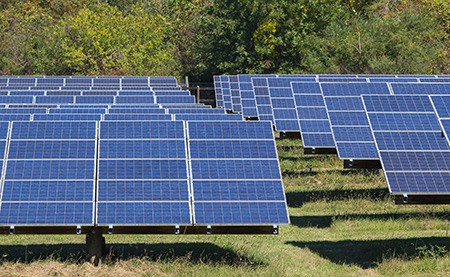Wind speed the height of the panel above the roof and the relative location of the panel on the roof.
Wind loads on ground mounted solar panels.
Characterise the net wind loads on the ground mounted solar panels in the large solar farms.
The wind loads on these solar panel arrays must be quantified so that the panels and its structural mounting system can be designed satisfactorily.
0 5 to 1 m.
The wind subjects the solar pv modules and the pv mounting system to excessive force and the wind load influences how close the solar pv panels must be mounted to the edges of the roof.
Today s photovoltaic pv industry must rely on licensed structural engineers various interpretations of building codes and standards to design pv mounting systems that will withstand wind induced loads.
As wind encounters the first row of panels before impinging upon the array it sets up a flow pattern that creates alternatingly high and low pressures very similar to the wake behind a cylinder.
Wind tunnel studies of numerous ground mounted solar arrays have repeatedly demonstrated that such arrays suffer from significant edge effects the most common of which is vortex shedding.
This is a problem because although permitting agencies require assessments of the structural attachment of solar equipment to rooftops the safety and sufficiency of these attachments are not adequately addressed in any codes or standards.
3 use section 1609 4 2 and section 1609 4 3 to determine the exposure in those sectors.
2 twoupwindsectorsextending45degreesfromeither side of the chosen wind direction are the markers.
Ensuring that pv installations are safe and secure can involve custom testing methods such as wind tunnel testing or computer simulations which are acceptable if approved by a structural engineer.
However there is very limited wind loading data in a consistent format for the design of these systems.
4 the exposure with the highest wind loads is chosen for that wind direction.
In most instances where wind causes damage to a solar array failures occur due to weaknesses in the racking system or in the roof that your panels are mounted to.
Interpretations of building codes and standards to design pv mounting systems that will withstand wind induced loads.
I am an engineer learning how to design a ground mounted solar racking structure.
The resources i have are the ibc as well as asce 7 05 10.
Wind loading on solar panels depends on three basic factors.
Analysis the dynam ic.
The result is a multitude of code.
Find critical area or zones to strength the structural system of the solar farms.
When wind blows across a roof with solar panels it passes through the small space that typically exists between the panels and the roof or between your panels and the ground in the case of ground mounted systems causing a large amount of uplift to the panels.
The higher the wind load the larger the distance to the roof edge should be chosen.
The euractive roofer project undertook numerous wind tunnel tests using scale models of roofs with panels as well as testing theoretical calculations that can in time form the.

